|













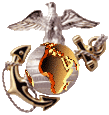

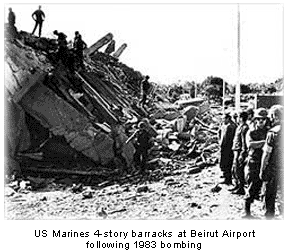
On October 23, around 6:20 AM, a yellow Mercedes delivery truck drove to Beirut International Airport, where the United States Marines had their local headquarters. It turned onto an
access road leading to the compound and circled a parking lot. The driver then accelerated and crashed through a barbed-wire
fence in the compound parking lot, passed between two sentry posts, crashed through a gate, and barreled into the lobby of
the Marine headquarters building.
The Marine sentries at the gate had loaded pistols but were not
able to stop the driver even though they shot at him. According to one Marine, the driver was smiling as he sped past him.
The suicide bomber detonated his explosives, which were equivalent
to 12,000 pounds (about 5,400kg) of TNT. The force of the explosion collapsed the four-story
cinder-block building into rubble, crushing to death many inside.

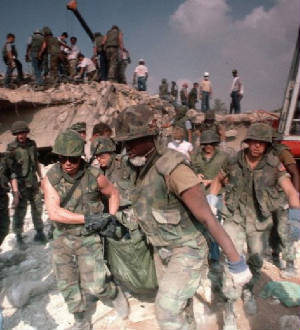
About twenty seconds later, an
identical attack occurred on the French Paratrooper barracks. A truck bomb drove down
a ramp into the building's underground parking garage and exploded, levelling the headquarters.
Rescue efforts continued for days.
While the rescuers were at times hindered by sniper fire, some lucky survivors were pulled from the
rubble and airlifted to Cyprus or West Germany.
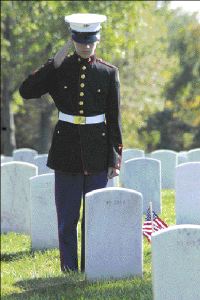
The death toll was 241 American servicemen: 220 Marines, 18 Navy
personnel, and 3 Army soldiers. 60 Americans were injured. In the attack on the French barracks, 58 paratroopers were killed,
and 15 injured. In addition, the elderly Lebanese custodian of the Marines' building was killed in the first blast; the wife
and four children of a Lebanese janitor at the French building were also killed.

President Ronald Reagan called the attack a "despicable act" and pledged to keep a military force
in Lebanon. Secretary of Defense Caspar Weinberger said there would be no change in the U.S.'s Lebanon
policy. On October 24 French President François Mitterrand visited the French bomb site. It was not an official
visit, and he only stayed for a few hours, but he did declare: "We will stay." U.S. Vice President George Bush toured the marine bombing site on October 26 and said the U.S. "would not be cowed by
terrorists".
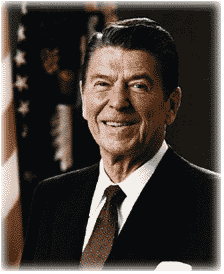
In retaliation for the attacks,
France launched an air strike in the Bekka Valley against Iranian Revolutionary Guard positions. President Reagan assembled his national
security team to devise a plan of military action, and planned to target the Sheik Abdullah barracks in Baalbek, Lebanon, which housed Iranian Revolutionary Guards
believed to be training Hezbollah fighters. However, Defense Secretary Caspar Weinberger aborted the mission, reportedly because of his
concerns that it would harm U.S. relations with other Arab nations. Except for a few shellings from the USS New Jersey off Lebanon, there was no real military
response from the United States in response to the barracks bombing; however, the US did become involved in several other
fights in Lebanon during their stay.
The Marines were moved offshore where they could not be targeted,
and in February 1984 the Multination Force withdrew from Lebanon. Terrorists
saw this as a two-fold victory for their cause, and their activity against Westerners (particularly Americans) increased,
prompting various U.S. responses. This event is considered by many to be the beginning of what is now called the War on Terror.




For the brothers I lost who have fallen
for our freedom I didn't say goodbye,
Though I know they paid the price that all who serve must be willing to die.
I
have those in my heart and though not in my sight, I know they're near at hand.
For when I die and lay to rest, as my final
Taps is played by the Marine Corps best.
It won't be 'Goodbye' I'll be saying, but 'See ya later' and 'Hello' to those
near at hand.
Jack Anderson.
Beirut Bombing Survivor
August 2005



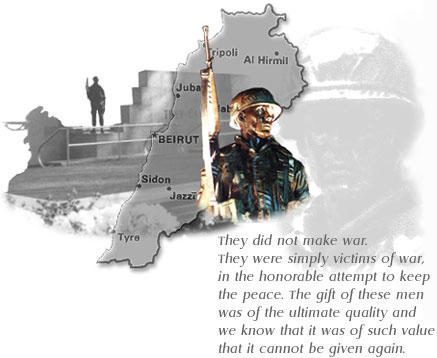



To honor the
Peacekeepers of
the
Multi-National Peacekeeping Force
Beirut, Lebanon
"They
Came In Peace"
Semper Fidelis




U.S. EMBASSY BOMBING
Beirut, Lebanon - 18th April
1983


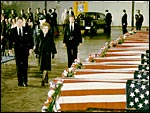
The Reagans honor the victims of the bombing
of the U.S. Embassy in
Beirut, Lebanon. 4/23/83





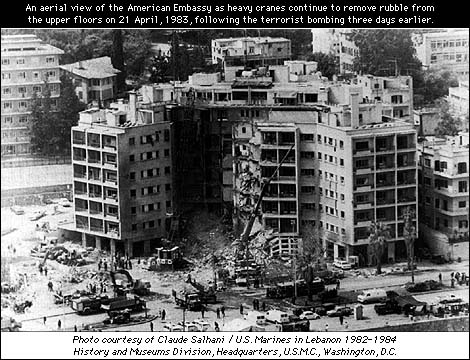





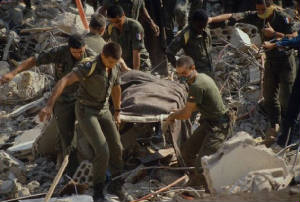
Occurred at about 1300
(1:00 pm Lebanon Time) on April 18th, 1983 Carried out by a terrorist driving a van, reportedly stolen from the Embassy in
June 1982. The van carried a 2,000-pound load of explosives, tearing
through the front portion of the seven (7) story building. Most of the victims were at lunch and were killed by the collapsing
building. Killed 63 occupants of the building, 17 of whom were Americans. One Marine was killed - Corporal Robert V. McMaugh,
an embassy guard. One journalist was killed - Janet Lee Stevens. Several State Department officials were killed, including
three USAID employees. The entire U.S. Central Intelligence
Agency Middle East contingent were killed. Several Army trainers were killed.



USS PUEBLO 23 January 1968 - 23 December
1968
Incident Personnel: 82 :: POWs: 82 :: POW Deaths In Incident: 1


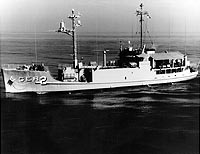


USS
Pueblo, an 850-ton environmental research ship, was built at Kewaunee, Wisconsin, in 1944 as the the U.S. Army cargo
ship FP-344. She was transferred to the Navy in April 1966
and renamed Pueblo. Initially designated a light cargo ship (AKL-44), she soon began conversion to a research ship
and was redesignated AGER-2 shortly before commissioning in May 1967. Following training operations off the U.S. west coast,
in November 1967 Pueblo departed for the Far East to undertake electronic intelligence collection and other duties.

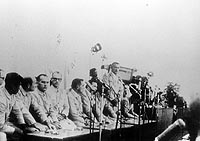
On 23 January 1968, while off Wonsan, North Korea, Pueblo was attacked by local
forces and seized. One crewmember was killed in the assault and the other eighty-two men on board were taken prisoner. The
North Koreans contended that the ship had violated their territorial waters, a claim vigorously denied by the United States.
After eleven months in captivity, often under inhumane conditions, Pueblo's crew were repatriated on 23 December 1968. The
ship was retained by North Korea, though she is still the property of the U.S. Navy. She was exhibited at Wonsan and Hungham
for three decades and is now a museum at Pyongyang, the North Korean capital city.



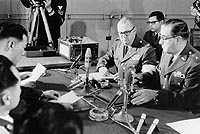
Repatriation of USS Pueblo Crew, December 1968
Representatives of the United States and North Korean governments meet at Panmunjom, Korea, to
sign the agreement for the release of Pueblo's crew, 22 December 1968.
Chief of the U.S. Delegation is Major General
Gilbert H. Woodward, U.S. Army, Senior Member, United Nations Command Military Armistice Commission (at right).
USS Pueblo
(AGER-2) and her crew had been captured off Wonsan on 23 January 1968.
Note tape recorder in the background.


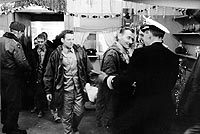






THE INVASION OF GRENADA
On Oct. 22, 1983, six East Caribbean
states formally requested American assistance in restoring democracy to Grenada. If the Cuban-fomented revolution there was
allowed to succeed, then they feared fore their own freedoms. Reagan said, "There’s no way we could say no to this request,"
[and ordered] "an outright invasion" of Grenada.





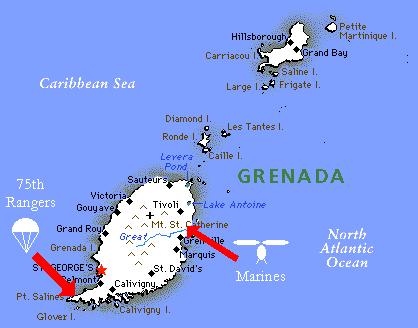


"Back home they’d hang me, but here they gimme a fuckin’
medal!"


On October 25, U.S. Marines invaded
Grenada, where they encountered unexpectedly heavy antiaircraft fire and ground resistance by the Cuban soldiers and laborers
building the controversial airstrip. In two days they subdued the air and ground forces.
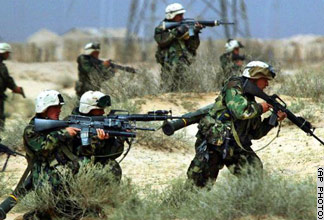
The 5,000-strong American invading force found on the island: a
cache of weapons that could arm 10,000 men -- automatic rifles, machine guns, rocket launchers, antiaircraft guns, howitzers,
cannon, armored vehicles and coastal patrol boats. In all, out of 800 Cubans, 59 were killed, 25 were wounded, and the rest
were returned to Havana upon surrender. Forty-five Grenadians died, and 337 were wounded. America also suffered casualties:
19 dead and 119 wounded. The medical students came home unharmed

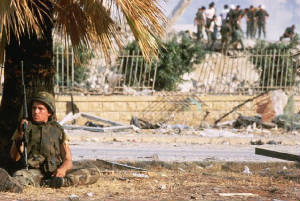
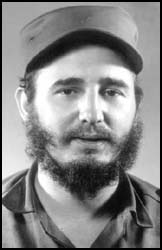
"A lovely little war" was what one correspondent called the 1983 U.S. invasion
of Grenada. Most saw Operation Urgent Fury, its official name, as a guaranteed victory. The Caribbean island, the smallest
independent country in the Western Hemisphere, was no match for American military might. Reagan championed the invasion as
another step toward ridding the world of Communism, but the big victory over the little island also served as a major public
relations coup for the recently battered administration.


"One of the main reasons that it is so easy to march men off to war," says Ernest Becker, is
that "each of them feels sorry for the man next to him who will die."


|

